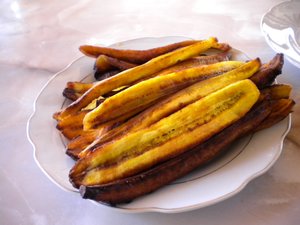Advertisement
Published: August 25th 2010

 Fried Bananas
Fried Bananas
They were quite delicious, but I could have forgone them in light of the fried rice and fried chickenWhen I was preparing for my trip to Bolivia and imagining the food, I was thinking it would be a lot like Mexican cuisine: spicy, delicious, piquant, etc. That, however, was not the case. Not entirely at least.
All in all, I would rate the food here as OK. Here's are a few stereotypes that I will throw out there:
1.
Bolivians love to cook with oil. Frying is a prime way of cooking because oil is cheap, it makes things taste better, it has a high energy density, and many Bolivians don't have easy access to an oven. Almost every dish that is made by a Bolivian has some degree of frying to it. The rice is fried in oil before it is steamed/boiled, to "toast" it a little bit. Even soups have to be cooked in oil to give it a little bit of flavor, likely a side effect of cooking with stock; as a result, they often have little globules of fat floating on the surface. A prime example of this stereotype is a meal we had consisting of a salad (shredded carrots and diced tomatoes=salad), fried chicken, fried rice, and fried bananas. While it tastes

 Llama Soup
Llama Soup
Note the tiny globules of fat. Llama meat is tough and chewy, but tastes like beef.ok, it is quite heavy, and it gets old fast. I told one friend over the internet, "While Bolivians don't eat a lot of candy, their regular food is something like junk food."
2.
It seems that all Bolivian food, even the water, has a certain Bolivian "taint" that t makes it taste different. All food, even the filtered water, has a certain flavor that runs through it that will always make me think "Bolivia." While I use the word taint, which may have a negative connotation, it is literally a matter of taste. While I don't consider the this flavor to be pleasant, it is not disgusting either. It's just there. Thankfully though, as I've gotten more used to it, it's become less noticeable.
I really can't explain it very well with words, it's as if everything tastes like Bolivia.
3.
Rice is a staple. And chicken. I would estimate that for meals that Bolivians have cooked for us, 95%!o(MISSING)f them have had both rice and chicken (that's all meals except for one). The rice we buy comes in bags of 46 kg, which is a little bit over 100 lb, and it's super cheap. Chicken is just plentiful plain ; you can't go into a marketplace without seeing chicken bits for sale. I'm surprised that potatoes aren't just as ubiquitous, as they are super cheap as well (5 lb for less than a dollar? Good deal).
4.
Dinner is really late here. I really should write a blog on Bolivian punctuality (or lack thereof), because this may be an offshoot of that, but a Bolivian-prepared dinner usually starts at 8 pm or later. I believe our latest dinner was at 10:30 pm, though that was a special case because we ordered pizza and the horrible traffic kept us from getting it home and enjoying it at the reasonable hour of 9:30 pm.
I will update this as new trends become apparent, but I want to give you all something to read in the meantime. Pray for my trip! Ciao!
Advertisement
Tot: 0.097s; Tpl: 0.01s; cc: 9; qc: 51; dbt: 0.05s; 1; m:domysql w:travelblog (10.17.0.13); sld: 1;
; mem: 1.1mb

 Fried Bananas
Fried Bananas
 Llama Soup
Llama Soup